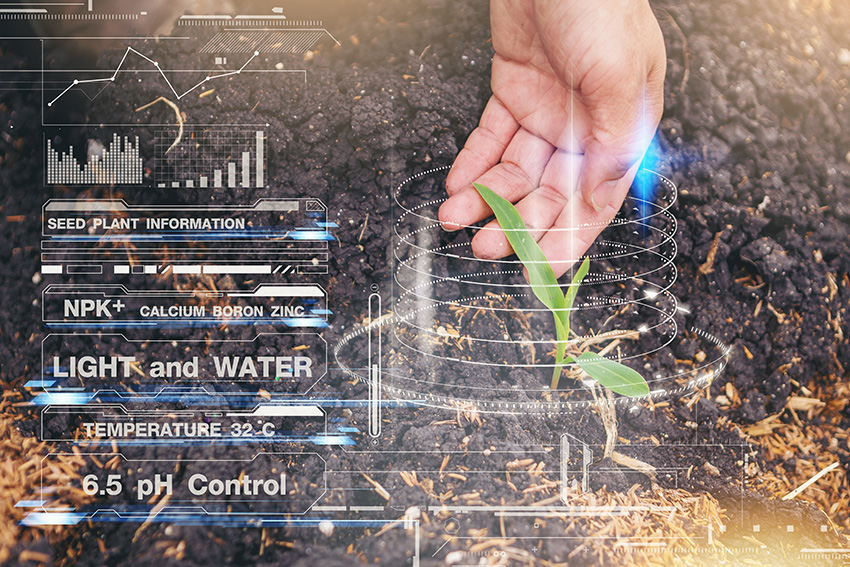What is Smart Farming?

Farming has traditionally been a manual, labor-intensive industry. With technologies such as the Internet of Things (IoT), Big data & Analytics, Artificial Intelligence (AI), and Machine Learning (ML) progressing in almost all the listed industry sectors, how is the farming industry evolving?
According to the Food and Agriculture Organization (FOA) of the United Nations, the world population is going to grow to 8.5 billion by 2030 and 9.6 billion inhabitants twenty years after that. It is estimated that to feed our growing population, food production must increase by 70% considering limited agricultural land, scarcity of freshwater, and changing climate conditions.
To address this challenge, efforts are in place to improve the quality and quantity of agriculture products by making them ‘Intelligent’ and ‘connected’ through “smart farming,” also referred to as “precision farming.” Precision agriculture as an industry is poised to grow to 43.4 billion USD by end of 2025.
So, What Exactly is Smart Farming?
Smart farming is often referred to as the 4.0 green revolution in agriculture, combining agriculture methodologies with technology – Sensors & Actuators, Information and Communication Technology (ICT), Internet of Things (IoT), Robotics and Drones – to achieve efficiencies of production with managed cost. It has been estimated that 80% of US farmers have started using Smart Farming technology to some extent.
Smart Farming Technology
The IoT structure is based on three layers; the perception layer (sensing), the network layer (data transfer), and the application layer (data storage and manipulation).
This layer consists of WSN, RFID, and, recently, Near Field Communications (NFC). There is some overlap between WSN and RFID technologies since semi-passive and active RFID tags can also be regarded as wireless nodes with lower computational and storage capacity. Typically, a wireless sensor node consists of a processing module, usually a low-power microcontroller unit (MCU), one or more sensor modules (embedded or external analog or digital sensing devices), and an RF module supporting a low-power wireless technology.
WSNs are often met in several works related to monitoring and climate control of storage and logistics facilities. RFID tags contain data in the form of the Electronic Product Code (EPC), and the RFID Readers are triggering, reading, and manipulating many tags. Offering object identification, tracking, and data storage on active or passive (without the need for embedded power supply) tags, RFID and NFC technologies play an important role in the agricultural domain. Typical user scenarios include products or livestock monitoring, supply chain and quality control tracking, and lifecycle assessment of agriculture products.
The second layer of IoT, wireless sensor nodes interacting with physical objects and/or their environment, communicate with their neighboring nodes or a gateway, building networks through which the data are usually forwarded towards a remote infrastructure for storage, further analysis, processing and dissemination of the valuable knowledge that can be extracted.
Communication protocols built over wireless standards facilitate device networking and bridge the gap between the internet-enabled gateways and the end-nodes. Bluetooth Low Energy (BLE), LoRa/LoRaWAN, DASH7, and low-power WiFi have also appeared in several deployments recently.
Finally, for the sensed data to have a real value for the end-user or another system (in the case of M2M scenarios), they must be stored, analyzed, synthesized, and presented in an understandable and intuitive manner. Big Data is one side effect of the continuous data flow coming from billions of geo-distributed devices and has three dimensions, namely volume, variety, and velocity.
WSAN (Wireless Sensor-Actor Network) paradigm, i.e., distributed smart devices sensing and transferring data to a sink and/or driving one or more actuators, moves one step further towards interoperability of devices and objects. Other aspects of IoT include technologies that support the intercommunication among devices and/or end-users, as well as the platforms, the software, the hardware abstractions, and the programming tools, over which developers and providers can build new applications and services.
Benefits of Smart Farming Systems
Automation and mechatronics have enabled huge steps forward in production efficiency, quality improvements, and sustainability.
Smart Farming Systems can reduce waste, improve productivity, and improve resource management. By linking local sensors to smart irrigation and control, things like sensing the pH balance of the soil, gauging local temperature are now possible through remote monitoring and sensing rather than walking the field. This leads to an increased yield as farmers can save on time and focus on fixing issues of pest control, irrigation, and amending soil conditions.
Precision farming system has a lot of dependency on the software management systems. Control systems manage sensory input, delivering remote data for supply and decision support, as well as automation of machines and instruments for acting in response to rising problems and production support.
On the supply side consider the supply of land, analyzing the conditions – moisture, pH, need for fertilizers.
During production, it is mostly resource management from a growth and yield perspective. For instance, precision seeding using automated tractors to reduce seed loss and seeding with proper space management between different plants. Another example is precision water delivery.
On the demand side, it is about demand forecasting and delivering goods just in time to reduce waste.
Also, seasonal climate conditions can be monitored and forecasted for better planning right from sowing seeds, growth phase, and providing the final crop output to the customer.
One subset to Smart farming is Precision Livestock Farming PLF where sensors are used to determine reproduction cycles and monitor the health of livestock. Monitoring of data includes activity tracking, tissue resistivity, pulse, and GPS location.
Growing Demand for AG and Diesel Technicians
As technology advances, the skills needed to work on the smart systems have evoloved. Now, technicians use electronic systems to work on trucks and use laptops to diagnose problems and adjust engine functions.
With Industry 4.0 we have seen a shortage in the manufacturing workforce. Agriculture and diesel technicians require advanced training to work on the machines needed for Smart Farming 4.0 advances.




